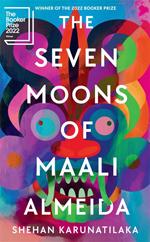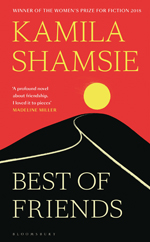 The Booker Prize winner was announced this week – we looked at the shortlist a little while ago. Slightly disappointingly, the prize did not go to my childhood literary hero Alan Garner, aged 88. The judges gave this year’s award to Sri Lankan novelist Shehan Karunatilaka for his book The Seven Moons of Maali Almeida. The novel is a fine illustration of a key thought from Chinua Achebe’s essay ‘What Has Literature Got To Do With It?’ In the conclusion, he says:
The Booker Prize winner was announced this week – we looked at the shortlist a little while ago. Slightly disappointingly, the prize did not go to my childhood literary hero Alan Garner, aged 88. The judges gave this year’s award to Sri Lankan novelist Shehan Karunatilaka for his book The Seven Moons of Maali Almeida. The novel is a fine illustration of a key thought from Chinua Achebe’s essay ‘What Has Literature Got To Do With It?’ In the conclusion, he says:
Literature, whether handed down by word of mouth or in print, gives us a second handle on reality, enabling us to encounter in the safe, manageable dimensions of make-believe the very same threats to integrity that may assail the psyche in real life.
Karunatilaka’s story gives a ‘second handle’ on the grim historical reality of Sri Lanka’s civil war, where countless atrocities were committed by each side. It is estimated that 100,000 people lost their lives during the insurgency of the Tamil Tigers and the government’s suppression of their revolt. Such a conflict does not cease when the guns fall silent; it leaves scars which continue to maim and hurt. There was an important move forward this year when a public memorial was held for all lost in the war, including Tamil civilians and rebels. Even so, it is hard to make sense of such remorseless violence and bloodshed. Like Salman Rushdie’s exploration of Indian partition in Midnight’s Children, Karunatilaka has chosen magic realism as his medium, the central character being a dead man, because, as he says, ‘only the dead could offer plausible explanations of the Sri Lankan tragedy, as the living clearly did not have a clue’. That comment clearly chimes with Achebe’s view of the value of ‘make-believe’ and part of the way The Seven Moons of Maali Almeida retells horrific history in ‘safe, manageable dimensions’ is by humour. As the Chair of the Booker judges said, the novel is marked by the ‘hilarious audacity of its narrative techniques’.
Read a review of the novel and a consideration of the rest of the shortlist here. And if you are interested in other ways in which Sri Lanka’s troubled history has been treated in fiction, you could try Michael Ondaatje’s Anil’s Ghost, where forensic archaeology reveals more than it should and the novel ends with the pace and tension of a thriller.
 While we are talking about literary prizes, 2018’s winner of the Women’s Prize for Fiction has just been released in paperback. Best of Friends by Kamila Shamsie, exploring the relationship between two Pakistani girls who end up as women pursuing very different paths in London, has garnered a lot of praise. The New Statesman lauds the veracity of observation in the novel, commenting, ‘Fiction is often fixated on love and violence; there are not enough thoughtful novels about work – the stuff we spend most of our time doing – but this is one of them.’ The Guardian has one or two reservations about Shamsie’s style, suggesting that ‘Shamsie doesn’t seem to realise what Zahra [one of the two central characters] grasps at 14: a subplot is often more compelling than the main story.’
While we are talking about literary prizes, 2018’s winner of the Women’s Prize for Fiction has just been released in paperback. Best of Friends by Kamila Shamsie, exploring the relationship between two Pakistani girls who end up as women pursuing very different paths in London, has garnered a lot of praise. The New Statesman lauds the veracity of observation in the novel, commenting, ‘Fiction is often fixated on love and violence; there are not enough thoughtful novels about work – the stuff we spend most of our time doing – but this is one of them.’ The Guardian has one or two reservations about Shamsie’s style, suggesting that ‘Shamsie doesn’t seem to realise what Zahra [one of the two central characters] grasps at 14: a subplot is often more compelling than the main story.’
If you are amused and intrigued by surprising connections, how about pop artist Prince and 19th century novelist Charles Dickens? It’s an intriguing juxtaposition explored with insight and humour by novelist Nick Hornby here.